

 NEW!
NEW! 




 NEW!
NEW! 


 New Offers
New Offers
Own Design AngeliquesFor my personal use, I developed two Angeliques (Bass and Treble) which possibly never existed like that.
Their sound is so outstanding that they may be interesting for others as well. See the details below. |
|
Own Design Bass AngeliqueString lengths: 73/160 cm Tuning:
Price: € 4450.- - neck and extended neck veneered with rosewood Price: € 4950.- - in the level shown on the pictures |
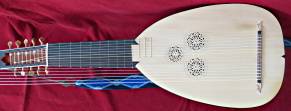

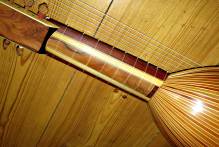
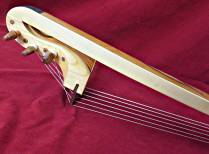
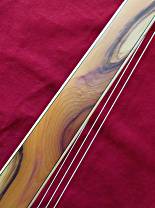

|
Own Design Treble AngeliqueString lengths: 55/110 cm Tuning:
Price: € 3950.- - neck and extended neck veneered with rosewood Price: € 4600.- - in the level shown on the pictures |


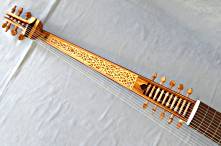
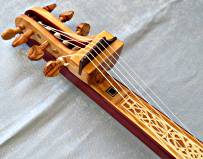
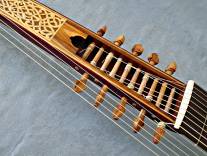
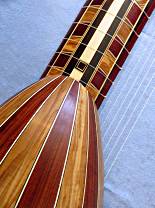
|
Body after "Martinus Selos"String lengths: 82/150 cm
Price: € 4000.- |
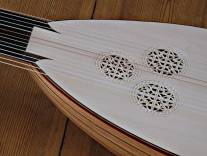
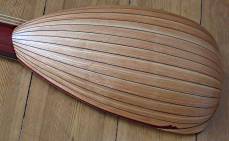


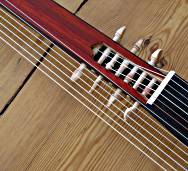
|
Own Design French TheorboString lengths: 81/160 cm 9 ribs The instrument's tuning is like on the other theorboes. The differences are in the single rose, the carving underneath the first pegbox and the different shape of its extended neck.
Price: € 4300.- |


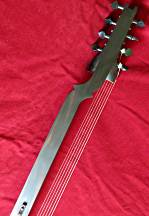
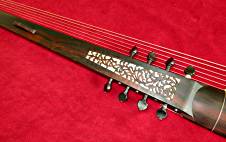
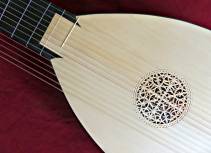
|
Romantic Guitar after "Mougeot"This is a copy of one of my two original Mougeot guitars. Not much is known about its maker from the early 19th century, but his instruments are certainly worth being copied.
Price: € 3650.- |
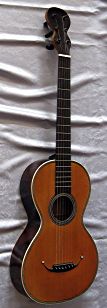

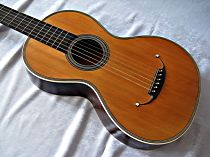
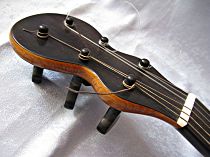
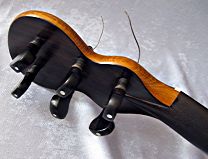
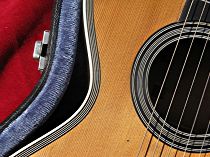
|
Theorbo after "Matteo Sellas in Venezia 1647"This slightly altered version of the original instrument makes a very good and loud sounding theorbo with a string-length of 85 cm. There is an increasing demand for this size of theorbo.
Price: € 4150.- |
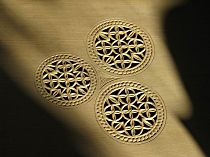
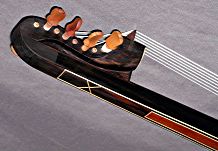

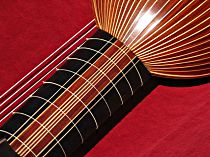


|
Wolfgang Wolf, Füssen 16th century12 course double headed Lute (French Lute); Tuning: g', e', c'c', aa, ee, Hh, Aa, Gg, Ff, Ee, Dd, Cc String-lengths:
Price: € 4050.- with carved pegboxes Price: € 3550.- with plain pegboxes Mathias Rösel from Bremen who investigated the history of this instrument wrote an
interesting article about it. |



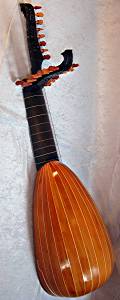
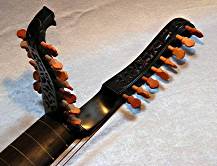
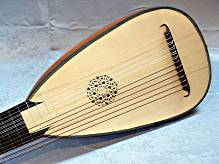
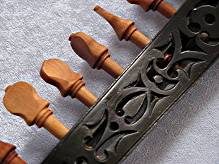
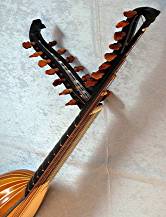
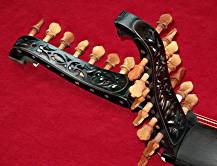
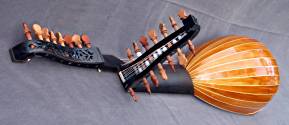
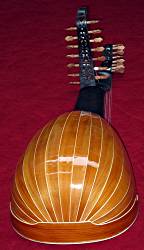
|
Renaissance Lute after "Wolfgang Wolf"This instrument is exhibited in Füssen/Germany in an altered version as a French doubleheaded Lute. Its original version must have been something like the lute I'm offering now: 6 - 8 course instrument with a string-length of 60 cm. Its body's deep and slender shape creates an unusual and special kind of sound.
Price: € 2950.- , construction level as shown |
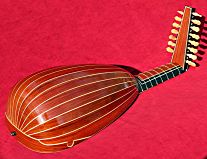
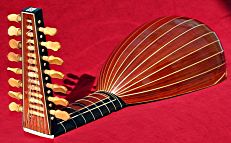
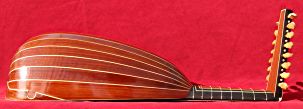
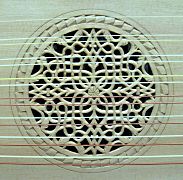
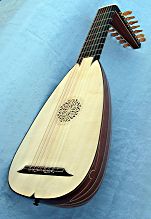
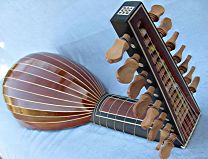
|
Chitarrone Francese / Arciliuto as a Combination InstrumentMany people wondered what kind of instrument the Chitarrone Francese might have been.
It was supposed to be a kind of baroque-guitar with additional diapasons.
A guitar-like instrument with an extended neck has not survived, though. There are many reasons for the assumption that the painting shows at least one variation of a Chitarrone Francese. But maybe we will never know exactly. Driven by my curiosity, I built such an instrument. The result is very convincing. The Edinburgh luteplayer Rob MacKillop introduces this instrument in a video clip. For my version of this instrument, I modified the original design slightly. Thus, there are 2 possible tunings: The string-lengths of the instrument are 64 cm and 115 cm. More details on the Arciliuto page! |



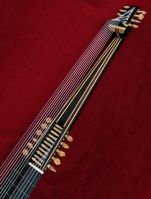
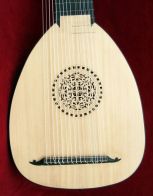
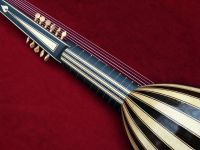
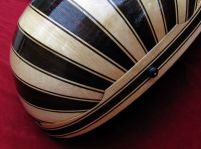
|
 Miscellaneous
Miscellaneous
Strawberry TreesFrom almost every vacation I return with a heavy rucksack packed with a large chunk of some kind of wood, which I try for lutemaking. Some years ago, I carried a cracked-off branch of a strawberry tree from Turkey. This way I came to using it for pegs - which turned out to be a good discovery: After all the kinds of woods I had tried so far this was clearly the best. It has the right density, becomes very light in the end, and above all has a very smooth surface. During my last holidays in Turkey I found a tree blown over from last winter which got me sufficient supplies for the next years! Strawberry trees can be found in parts of the Mediterranean Sea and along the Atlantic up north to England and Ireland. In the Mediterranean they usually form the undergrowth of pine-forests, growing up to 5, sometimes up to 10 meters. Their leaves are evergreen. They are in blossom most of the year. In winter, their 2,5 cm sized strawberry-like fruits get ripe. They can be eaten but don´t taste quite as good as real strawberries. In some areas they are distilled to spirits. Strawberry tree stems have a very smooth silky surface. There is ever only one layer of bark, because in summer last year's bark peels off, creating interesting appearances. The wood has a pink tone, getting more reddish towards the core. |


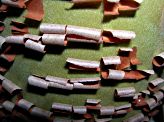

|
New in my collection of Romantic Guitar originals:
|
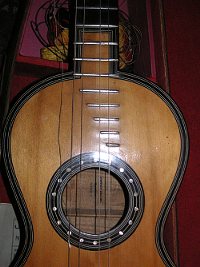 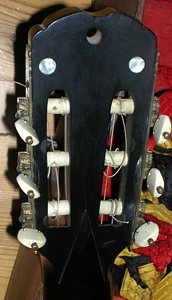 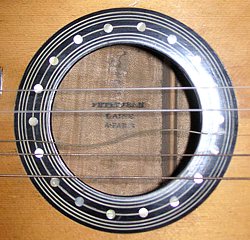 |
A small guitar with a big sound -
|
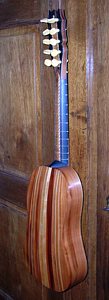 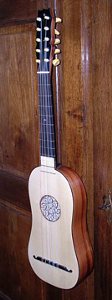 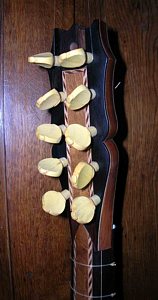 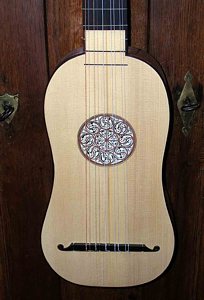 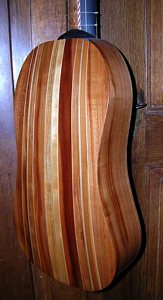 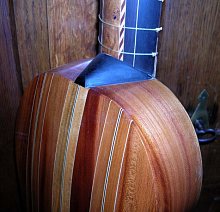 |
A "new" Pietro Raillich luteLast year I received an offer from Prague of the opportunity to buy an original Railich lute. Even from the pictures attached it was obvious that this was an interesting instrument. As I expected the asking price was far above my means. I also thought that a museum would be the most suitable place for it. So I wanted at least to gather all information I could about this lute before it was sold, in order to build copies. At the beginning of May I booked a bus to Prague to take pictures and measurements. This lute left me full of exitement because it was obvious that the lute and its case have not been altered since the 18th century. It is a comparably small instrument quite different what one would expect, judging from the other surviving Railich instruments. The outline of the table reminds one a bit of the "Laux Maler" lute converted into a baroque lute which is now in the Germanisches Nationalmuseum in Nurnberg, though it is smaller, and not quite the same. The two lables inside the body read: PIETRO RAILLICH AL SANTO IN PADOUA 1669 and JOHANNES ANTONI FICHTL IN WIENN 1720 On the second label in handwriting it reads before the IN WIENN 1720 "zu gericht" which means "trimmed". A date of 1669 makes it the latest surviving instrument built by Railich. In my opinion this lute (except maybe for the partial replacement of the table) was brought into its present state 1720 by J.A. Fichtl in Vienna. A sort of swan neck (stained black) replaced probably a bent neck (theoretically it also may have been an extended archlute neck - but in this case I believe they just would have altered the old neck for the new purposes). There are 12 pegs at the first pegbox and 8 pegs at the second, which means 7 courses (2x1 and 5x2) running to the first, and 4 courses on the second pegbox (4x2). In 1720 the "standardised" swan necks (with 13 courses, 8 courses at the first and 5 courses at the second pegbox) had not quite developed to their final shape. This explains the slightly different shape with only 7 courses at the first, and only 4 courses at the second pegbox (8 courses at the first pegbox are required for most later music). So its state as at 1720 makes it a typical "transitional" baroque lute. One can speculate on as what kind of lute Raillich built it in the first place. Three types of lutes could be possible: A 10 course lute with a bent pegbox, an archlute, or an angelique. There are angeliques looking very similar. In that case even the extended neck could be original Raillich - a very tempting idea! The string-length of the first seven courses is 66 cm, and 95.5 cm at the extended neck. The neck could be original Railich (with a "typical" 10-course string-length); it would have accomodated 10 courses, perhaps running to a slightly narrower original bridge. The bridge, probably made by Fichtl, has 9 double holes and a slot that can take either 1 or alternatively 2 single courses. Using the slot with one course in the middle gives the best alignment to the neck. So the lute in its final and current state could be played either as a 10 or an 11 course instrument. The table includes a strip of wood about 6 cm wide at the neck end adjoining the main part of the soundboard; the grain of these two pieces of wood do not match. The short strip slopes underneath the long part at the point of repair; this may mean that the shorter piece of wood is part of Railich´s original. The rosette is not cut out of the table, but glued in, as with many repaired lutes. The body consists of 21 snakewood ribs, without lines in between the ribs. The first rib on either are wider than the rest. The case is probably contemporary with the 1720 restoration, or in case the lute was an angelique in the first place it could be from 1669. It was built of thin wood (spruce ?) and is locked with an "old-fashioned" key. In the area of the body the case is made of ribs (similar in construction to a lute body). On the inside it is wrapped all over with marbled paper which in the baroque and rococo periods was considered rather luxurious. |
  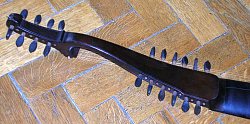 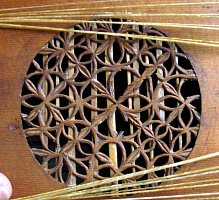 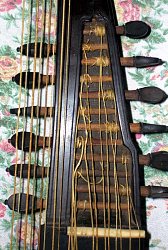 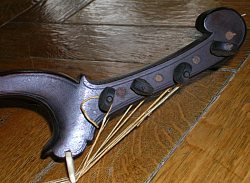  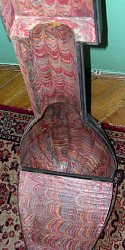  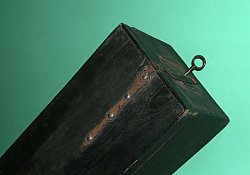 |
|
My first copy This year I completed my first copy of the Raillich 1669. According to my customer's wishes, I built it in a 13 course version. I was very curious of how it would sound. Playing it for the first time immediately made it clear that this is a very good model. It has quite some loudness considering its small size. What impresses most is that there is almost no echoing which you normally have with multi-course lutes. The sound speaks very directly. This lute is ideal for everybody who wants to play a smaller string-length (68 cm). Here are some pictures of my copy! |
  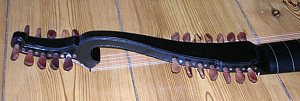 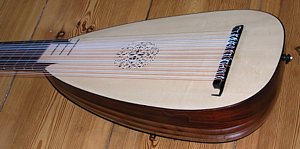 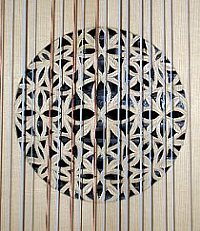 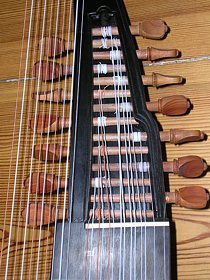 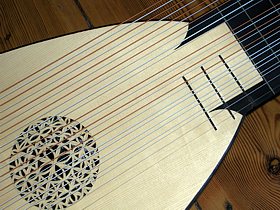 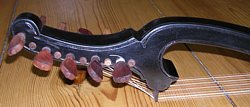 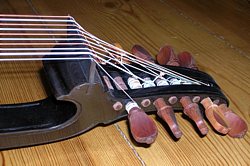 |
"Brevete du roi" - Another original René Lacôte Romantic Guitar[Rene Lacote]During the first half of the nineteenth century, René-Lacôte was the most successful luthier in France and also highly esteemed in other European countries. His output was considerable which did not effect the quality of his craftmanship. He also introduced several innovations - the best known are his early metal/wood pegs and his tuning-machines inside the pegbox of his late years. It is said that the number of surviving original Lacôte guitars is going towards 200. Anyway - since last year it got one more! I had the chance to buy one in England that none of the experts had heard of before. It was found in a loft in a village close to London some 30 years ago. The former owner just kept it with his other modern guitars as it was not in a playable condition. Now I have got it here waiting to be restored. The guitar is from Lacôte's late years. In 1839 he received a medal for one of his guitars (Médaille à
l'exposition 1839), and he was given a patent by the king (Brevete du roi). This king can only have been the last king of France Louis Philippe, a decendant of Louis XIII. It looks like the renovation is going to mean very much (nervwrecking!) work - the bottom has to be taken off like the neck which was repaired poorly in the past. The (now broken off) pegbox will have to be restored or replaced. Also the internal tuning-machines are missing. I'll present the result of the restoration work - once it's ready. Here are the first pictures of this beautiful instrument in its present condition. |
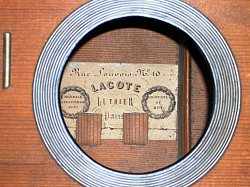 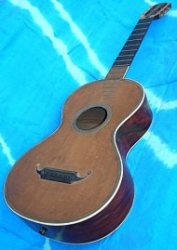 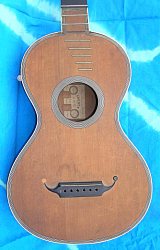 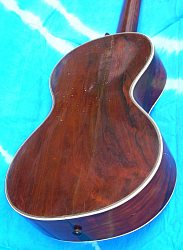 |
Only scarcely noticed: Magno Stegher in Venetia 1598A much bigger share of bass-lutes than these days must have been played considering the comparably large number of instruments one finds among the surviving lutes. In most cases these bass-lutes were transformed into baroque-lutes later. One good example for these instruments is the "Magno Stegher in Venetia 1598". It was only scarcely noticed so far because it is not being exhibited. This instrument was built 1598 by the Allgäu lutemaker Stegher as a typical bass-lute of that age. The body he built of 27 ebony-ribs with ivory-spacers. The veneer on neck and pegbox was made of the same materials. It´s quite likely that in its first version it had 10 courses. On top of the "Magno Stegher"mark there was one of "Magno Dieffopruchar"- so either he did some repairwork on this lute or somebody thought it might sell more expensively with that name. Into its present shape as a 11-course baroque-lute with a string-length of 72 cm it was brought the 2nd half of 17th century. Some people believe it may have been done by "Thomas Edlinger". If it was turned from a 10-course bass-lute into a 11-course baroque-lute it just meant adding a treble-rider and replacing the old bridge by a new one with 11 courses. It is quite likely, though , that the original neck was shorter as bass-lutes usually had less frets. Repairs were made in 1772 in Antzenberg and after in Hornberg, Baden (?), names cannot be identified. 1934 this lute was repaired in the "Peter Harlan workshop" in Markneukirchen (Vogtland). Later the instrument was destroyed by much too strong strings (Cello- thickness (!) -they still exist at the museum). The pegbox was torn from the neck, the table ripped off the body and the body itself broke close to the block. The single parts are being kept at the Berlin "Musikinstrumentenmuseum" in Tiergartenstr. 1, 10785 Berlin. It is not part of the exhibition. Like some other interesting instruments it is being stored in the cellar. For anybody looking for a bass-lute the "Magno Stegher in Venetia 1598" is a very good model to be copied. I have built a few copies and always liked the results very much. (There are some more details on the Renaissance lute) page). |
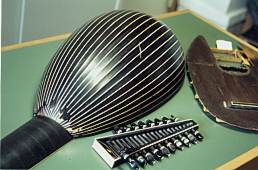 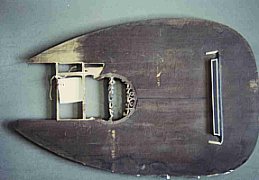 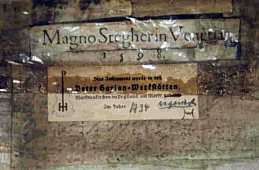 |